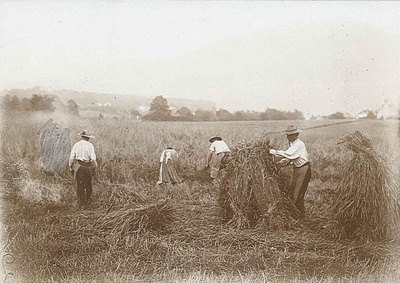Funded by the Austrian Science Fund (FWF), this project analyses legal norms and administrative disputes concerning the regulation of agricultural labour in interwar Austria (1918–1938).
Funding
Fonds zur Förderung der wissenschaftlichen Forschung (FWF), P 32140
Duration
September 2019 – August 2022
Principal Investigator
Description
Regarded historically, what we understand today as work is relatively new. From the late nineteenth century onwards, vocations in the sense of a learned and continuous means of making a living outside of the home increasingly became the paragon and yardstick for all forms of making a living. This was to a large extent conditioned by administrative authorities, courts, and state institutions such as employment agencies or parliaments, as they strove for example to legislate the rights and responsibilities of the parties involved in labour, to regulate occupational training, to develop social securities, or to limit or promote labour migration through new means.
As a result, agricultural employment also changed, in Austria during the interwar period becoming newly regulated from a legal point of view and partly incorporated into social security. However, even among state institutions the question of how the activities of farm hands, agricultural labourers, day labourers, and so forth were to be categorised and regulated remained disputed. While some authorities aimed to incorporate agricultural activities into the administrative measures concerning the commercial labour market, others insisted on the specificity of agricultural labour and thereby on specifically tailored forms of regulation.
This project focusses on disputes and official measures concerning the regulation of agricultural labour. It proceeds from the premise that new forms of agricultural labour organisation emerged as a result of conflicts, competitions, and coalitions between various authorities, which were related to overarching changes in labour generally. The project undertakes a detailed examination of official measures and conflicts and assesses the extent to which the subsequent changes in agricultural labour led to new hierarchisations between labourers. To this end, it will systematically compare official documentation from the local through to the ministerial levels and from various administrative sectors with the help of correspondence analyses. It will thereby elucidate similarities and differences between official perspectives and measures as well as changes and impacts on agricultural labour.
Historical research has hitherto not dedicated itself in any systematic way to these questions. This project thus makes a contribution to research into continuities and changes in the organisation of agricultural labour that could also serve to answer to present-day problems (such as the lack of regulation of the employment of harvest hands). Since state interventions in agricultural labour will be regarded not in isolation but in relation to measures concerning commercial labour, this project moreover allows for a better understanding of the history of labour itself.
Illustration: Grain harvest near Altmünster (Austria), 1900. Photo by Philipp von Württemberg, Source: Wikimedia Commons.
